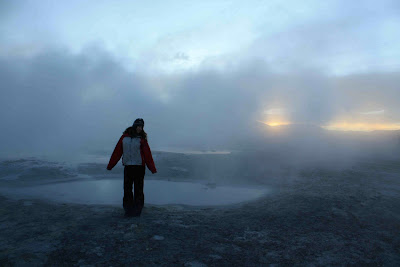Ah, yes. It's about time I introduced our splendid group. Let's see, we had Brice, who I just mentioned. He was always on-hand with the bottle of red wine whenever we ate (good man), lives in Brittany and smokes far too much for someone of just twenty-three years. Then, his friend Pierre, the same age and also from Brittany. He has spent time in Ecuador practicing Osteopathy. He speaks great Spanish and was very much the joker of the group. Next we had Florianne, 25, from Marseilles who is an animator by profession and was on hand with the candles when the electricity ran out. And last but not least her friend Cecilia, 21, also an animator back in France and who was cheerful and generally a pleasure to be around. There.
It was our turn to be in the back of the jeep. It was indeed lacking in legroom, however, despite the many miles we travelled on day two, we frequently stopped to admire views and take photos and stretch our legs. This day would mainly be about visiting a series of lakes. And on some of the lakes we got the rare chance of seeing flamingos! At one such lake we stopped and while Elias, our driver prepared lunch, we photographed the pink-coloured birds and the magnificent reflection of the mountains in the background.
Lunch, by the way, was delicious. I wasn't expecting much, it being served out of the back of the jeep in the middle of nowhere. But we had bread-crumbed chicken, potatoes, rice and salad. And, of course, wine!
With another day of sightseeing drawing to a close it was time to head for our second accommodation for the trip. Set around a lake, this hospedaje wasn't made of salt but was on par in terms of facilities. It was basic, as expected. But again, it did have electricity so we weren't in the dark after sundown. But what proved challenging was the temperature. It is difficult to tell exactly how cold it is. Having spent a fair part of our travelling days in hot places, I suspected I had become a little sensitive to a bit of cold. Or soft, you could say! And up at around 4000m the wind can really get to your bones. However, we were informed that it was very close to zero degrees celsius and by nightfall temperatures would reach a chilling minus sixteen! The thing here is that we did not have any form of heating. I'm pretty sure I've never felt as cold as I did that night. After playing poker and struggling to hold the playing cards wearing gloves, we called it a night and went to bury ourselves in sleeping bags and blankets before a five in the morning wake up call. Yeah, that was going to be a joy!
It was indeed a painful experience to get up at such an early hour and in such cold. Our guide popped his head in and informed us he was loading the car. I'm sure he hadn't slept without heating. The evening before I'd seen the next house along with smoke bellowing from its chimney giving me visions of all the guides curled up around a big fire like dogs.
Day three of our trip would be short but sweet. In the dark we drove along until we reached an area full of geysers. With the sun just coming up we had a good old nose around the dozens of holes with hot gases rushing up from them. It was amazing. Pretty smelly though. You could only endure the stench of rotten eggs for so long!
From here it was on to the thermal pool, and breakfast. When we pulled up the pool had many a white-skinned human in it already. The air temperature was still very very low, but most had braved it, stripped off and jumped in the warm water. All very well, but getting out again would be a tough task. Pierre and Bryce talked for a while and decided to go for it. Sophie and Floriane stayed in the car with a cup of tea and I copied Cecilia and dipped my feet in the pool, as a half measure. In my defense my towel was packed away amongst the bags on top of the jeep.
After breakfast we headed for the last stop, Laguna Verde - the lifeless lake laden with arsenic. If you catch it at the right time it is green, as its name suggests. This day it only had a slight tinge of green, but still a magnificent sight. From here it was onwards to the Chilean border where we would go our separate ways, the French heading back to Uyuni and us into Chile.
The cold temperatures was definitely the main challenge of the trip, not to mention second having to converse in Spanish with our new friends - all good practice. But, as I write from the comfort of my warm hotel room back in civilisation, I am so glad we chose to take the three day trip. The salt flats were out of this world, but the Bolivian desert, with its mountains, geysers and lakes were equally as impressive.


















































